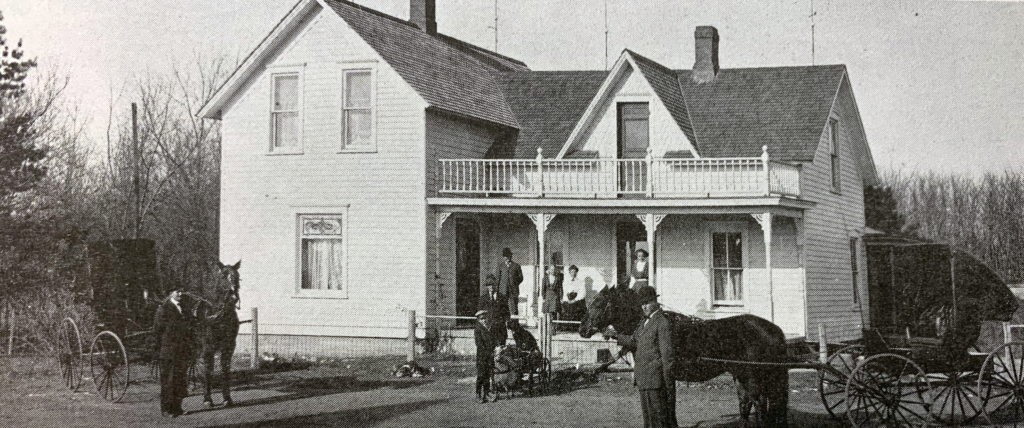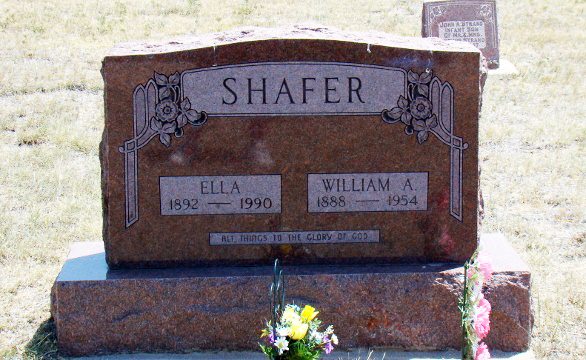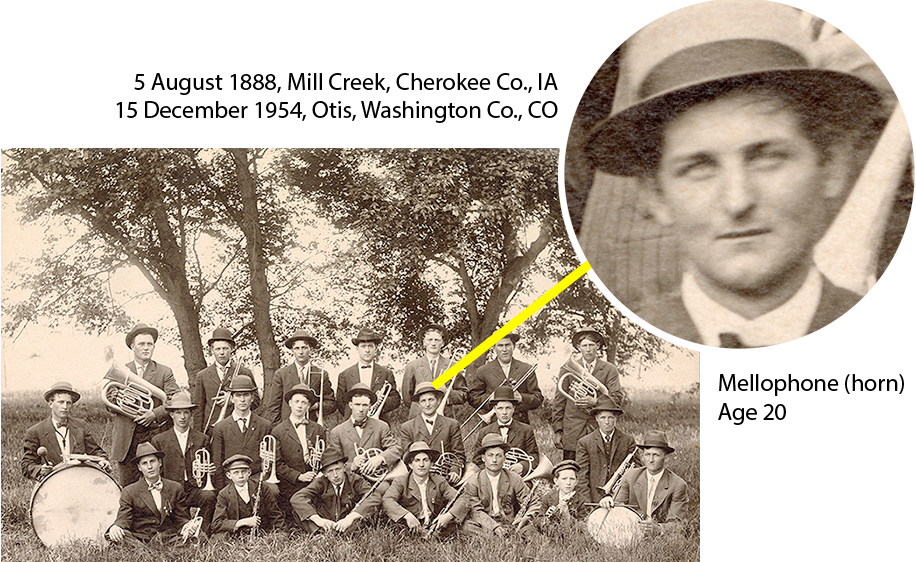
Remarkably, the brothers William Shafer (1888-1954) and Ernest Paul Shafer (1891-1964) are one of three sets of brothers who were in the Calumet German Band.(1) The others were Harry Rochel (1883-1965) and Charles Rochel (1888-1967), and John Mehrens (1889-1941) and Albert Mehrens (1891-1957). In other words, six of the 22 band members comprised pairs of siblings. In the case of the Shafer brothers, the band interconnections are even stronger (see box below).
William (called “Willie” at least in his youth), born in 1888, and Ernest, born three years later, were the first two in a family of seven children of Johann (John) Shafer(2) (1864-1949) and Johanna Ernestine Bochart(3) (1865-1943). Unusually among the families of band members, the German parental heritage is not that of Schleswig-Holstein but of areas in southern Germany. Perhaps not coincidentally, upon the emigration of John’s family from Germany to the U.S., in 1882, the family settled first in Ohio, not Scott County, Iowa, as was true of so many other Schleswig-Holstein immigrant families of this era. The family moved to Cherokee County in 1883, and it was at Cherokee where John and Johanna were married in 1887. After living there for several years, the Shafer family moved to Liberty Township, O’Brien County, in 1900.
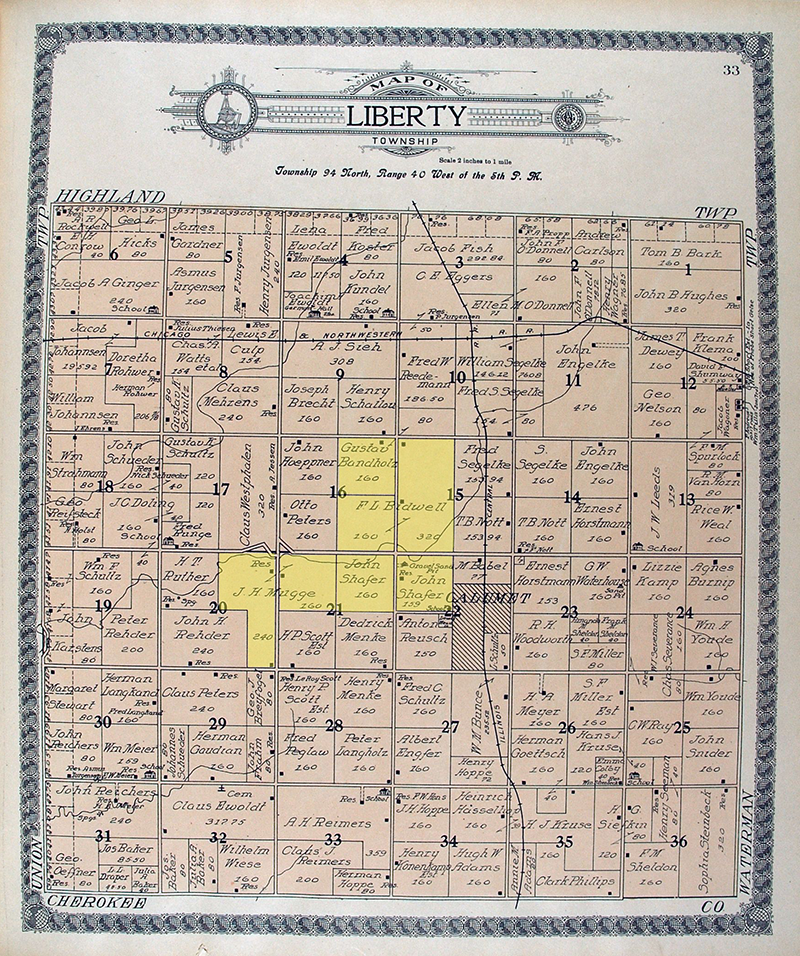
There John Shafer farmed on 320 acres immediately adjacent to the town of Calumet in Sections 21 and 22 of the township.
The other children of John and Johanna Shafer were Hermann, who died as an infant (1893-1894), Paul William (1895-1959), Elenora “Nora” Katherina (1897-1949), Olga Josephine (1900-1999), and Edwin Martin (1903-1988).
As noted above, there were three pairs of brothers in the Calumet German Band. But in a sweetheart connection that is almost too good to be true, two of these pairs of brothers married sisters. And in the case of the Shafer brothers, the sisters whom they married were themselves sisters of another bandmate, William “Bill” Eggers (1886-1968). Additionally, these sisters were first cousins of Harry Rochel and Charley Rochel, the other brothers who married sisters. So the marriages of the Shafer brothers directly connected more than one quarter of the entire band. (See the box below and associated schematics for visual representations of these relationships.)
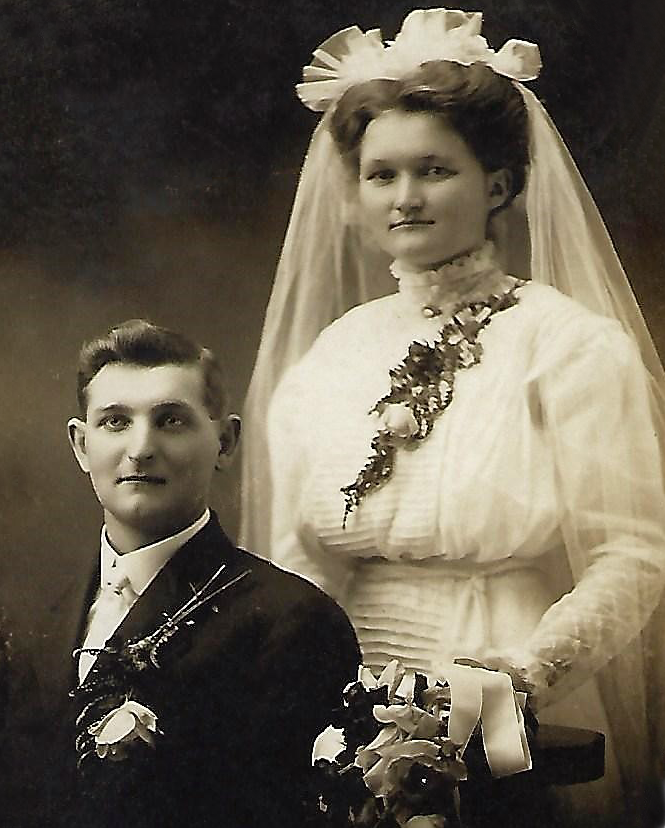
William’s marriage was to Ella Eggers (1892-1990), which took place on 25 January 1911 in Calumet. Ella and her sister Kathrine (“Katie”) (1889-1974) were the daughters of Claus Friedrich Eggers (1849-1913) and Kathryne “Katie” Rochel (1849-1932), two German immigrants who had displayed a typical migration pattern for many such immigrants to Iowa at this time, stopping first in eastern Iowa and Tama County, where Ella was born, before moving further west to O’Brien County. The marriage of Ernest Shafer and Kathrine Eggers took place almost two years after that of William and Ella, in December 1912.
As an aside to this account of the Shafer family, the father John Shafer played a role — although an unwilling one — in historically important incidents in O’Brien and Plymouth Counties that connect to national events of the 1930s: the Great Depression and the early years of the New Deal. In the years following the stock market crash of 29 October 1929, as farm land prices dropped precipitously and many farmers holding mortgages were caught in an economic vise, there was a raft of farm foreclosures. Attempts to politically organize farmers involved sometimes competing organizations (e.g., American Farm Bureau Federation, Iowa Farmers Union) and direct-action movements such as the Farmers’ Holiday Association. Another organization, active in northwest Iowa, was a secretive group called the Modern Seventy-Sixers, which took a militant stance.
Within this ferment of economic deprivation, farmer bankruptcies, and political turmoil, John Shafer in 1933 was fighting his own battle, a five-year struggle against foreclosure on the northeast quarter section of Liberty Township Section 21 (see plat map referenced above). On 27 April 1933, hundreds of local farmers, including some who were allied with the militant Seventy-Sixers, stormed the courthouse in Primghar (O’Brien County seat) in an attempt to stop a sheriff’s sale of Shafer’s land. Ultimately Shafer’s issue was resolved by his creditors, who reluctantly offered easier terms of payment, but later on the day of the hearing, the protesters traveled 40 miles to Le Mars (county seat of Plymouth County) to confront Judge C. C. Bradley in his courtroom as he was hearing arguments on Iowa’s new foreclosure moratorium law. Violence ensued, Judge Bradley was forcibly taken from the courthouse and physically abused (including an attempt to lynch him), and the governor called out the Iowa state militia. Martial law was briefly declared in Plymouth County. In the following days, John Shafer and his son Edwin Shafer were among 45 men arrested as a result of these disquieting incidents.(4)
The dramatic events that would embroil John Shafer in Depression-era financial trouble and the threat of foreclosure, however, lay two decades in the future when his sons William and Ernest married Ella and Kathrine Eggers in 1911 and 1912. In that more happy time, newly married couples pondered their opportunities and where best to settle down.
Shortly after their marriage, William and Ella decided to relocate from Iowa to Colorado. They purchased land near Otis, Washington County, in the northeast corner of the state, and they moved there and established a farm several years later.
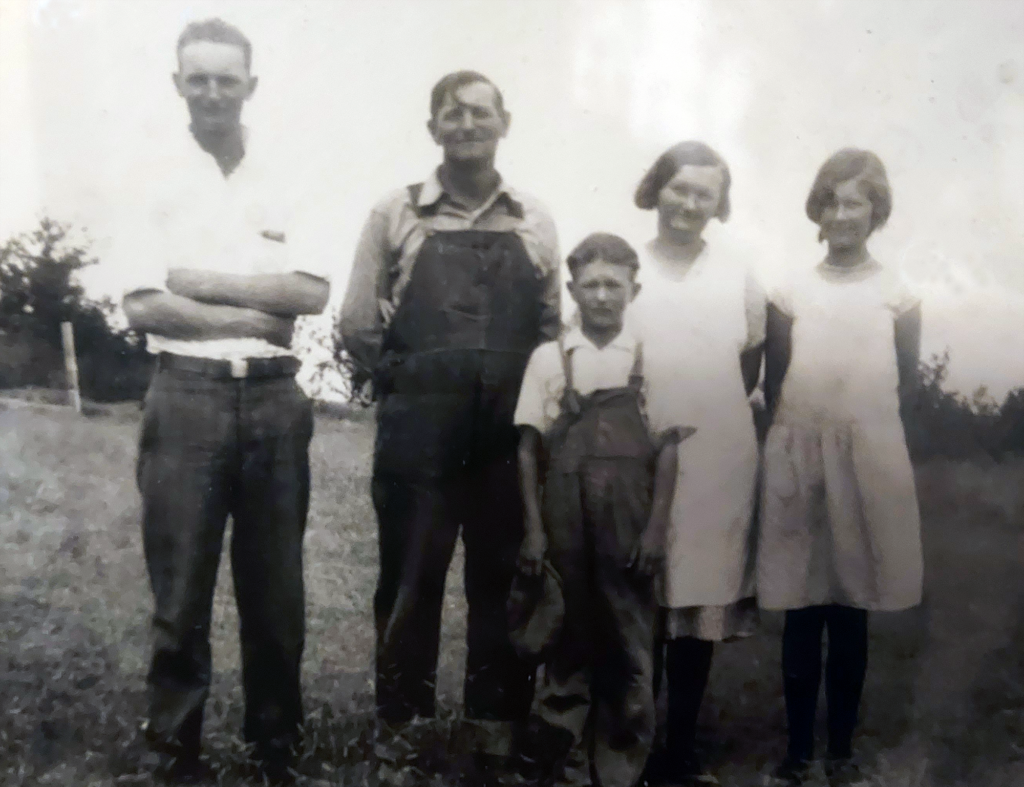
They continued to farm there for the remainder of their working lives, and they raised three children: Harry John Fredrick (1912-1959), Neva Hanna (1916-1998), and Harold William (1918-1991). In 1949, William and Ella retired to the town of Otis.
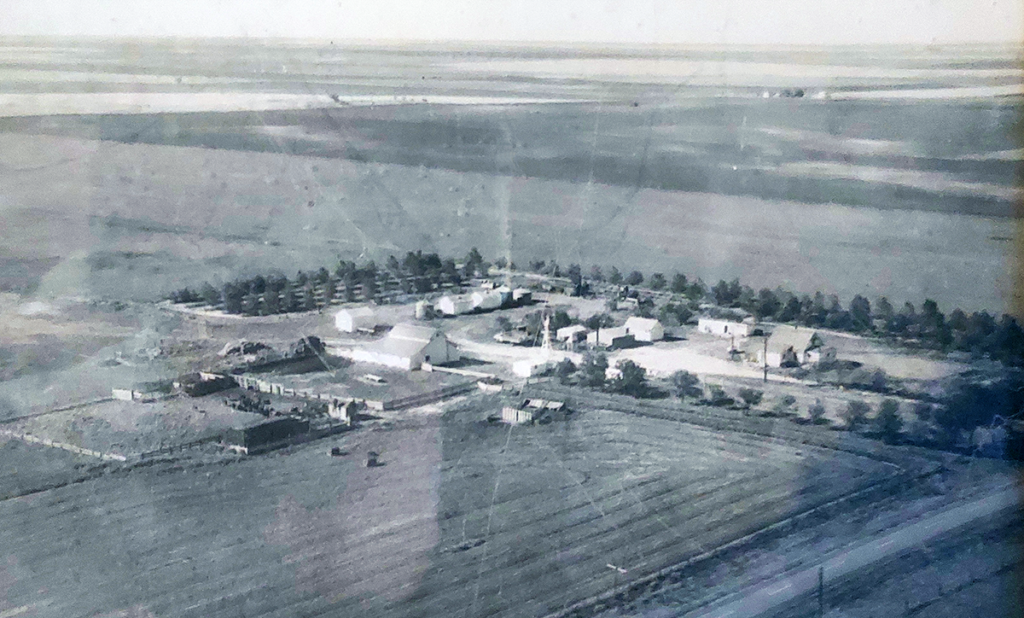
William’s retirement years were unfortunately cut somewhat short. He died at the relatively young age of 66. Ella Eggers Shafer remarried in 1970, to Ernest Matthews (1893-1979), and she lived for nearly another four decades, passing away at age 97 in 1990.
William and Ella Eggers Shafer are buried at Otis Cemetery, Washington County, Colorado.
All three of William and Ella’s children remained in the northeast Colorado region. The farm that they established near Otis remains in the Shafer family into the 21st century, passing to the Shafers’ son Harold and now to their grandson Jim. In 2010, it became a “centennial farm” (designating farms or ranches recognized as having been operated continuously by a single family for a century).

Subscribers to Ancestry.com may wish to further explore some family connections of William Shafer by accessing an Ancestry profile page (within the context of a “Mugge Family Tree”).
Connection to Other Band Members
As discussed in the main text, William was the brother of fellow bandmate Ernest Shafer, and the two brothers’ marriages to sisters Ella and Katie Eggers would make them brothers-in-law to William “Bill” Eggers, another band member.
In addition, because Ella and Katie Eggers’s mother was Kathryne Rochel, brother of Peter Holmer Rochel (1855-1942), the Shafer brothers had in-law relationships with band members Harry Rochel (1883-1965) and Charles Rochel (1888-1967).
This relationship is more easily seen in a schematic, available here.
And the connection with Bill Eggers also created connections with John Mehrens (1889-1941) and Albert Mehrens (1891-1957), whose brother Elmer Mehrens was married to Bill Eggers’s niece, Alice Meier (1906-1982). (The connection between Bill Eggers and the Mehrens brothers is seen in another schematic.)
Through chains of relationships, centering on Bill Eggers, who served as something of a focal point for several connections among band members — the Shafer brothers would also become distantly related by marriage to three Henrys among the bandmates: Henry J. Lorenzen (1890-1976), Henry W. Mugge (1891-1967), and Henry Friedrichsen (1889-1937).
Footnotes
(1) Much of the material for this biosketch having to do with family background repeats information that appears on the bio for William’s brother, Ernest Shafer.
(2) The surname was originally Schäfer, a family name that upon U.S. immigration was typically anglicized to Schafer, Schaefer, or Shafer.
(3) Spelled Bochert in some records.
(4) Those who wish to read further about these events and the larger issue of farm foreclosures in Iowa and the nation may wish to start with several resources: (1) “Foreclosure Melee Brings State Militia,” 4 May 1933, The Sutherland Courier, available here. (2) “Farmer Riots of the 1930s,” Millie Vos, 23 November 2020, nwestiowa.com, available here. (3) “The Iowa Farmer in Crisis, 1920-1936,” Joseph Frazier Wall, The Annals of Iowa, State Historical Society of Iowa, available here. (4) Cornbelt Rebellion: The Farmers’ Holiday Association. John L. Shover. (Urbana, IL: University of Illinois Press. 1965).

